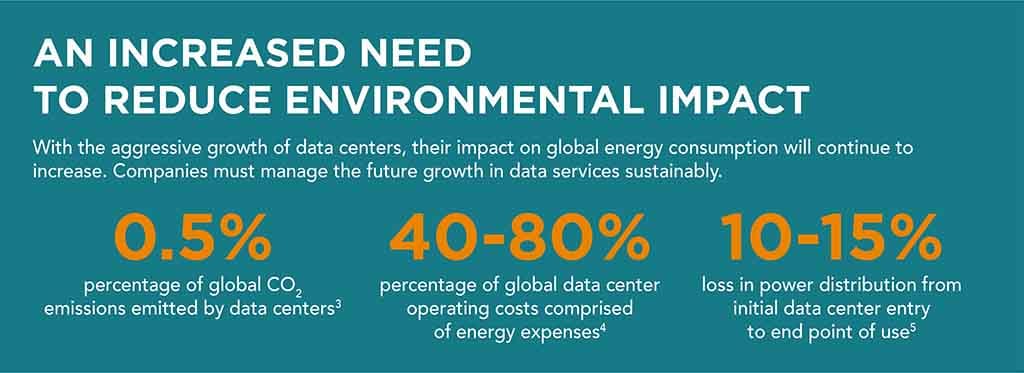
It’s no secret that we are in the midst of a global, humanity-altering boom in data and digital adoption. In 2010, the world collectively produced two zettabytes (2 trillion gigabytes) of data; and experts forecast we could generate 175 zettabytes annually by just 2025. In 2018, more than 2.5 quintillion bytes of data were generated every day, a figure that continues to increase exponentially.
This explosion of data is impacting our society in innumerable ways. From digitization of legacy commercial processes and procedures to the establishment of entirely new industries, high-speed data transmission and processing are helping to create a smarter and more connected world than ever before.
Data centers hold tremendous promise as the backbone of our digital future. As we seek to mitigate their environmental impact, TE is committed to working with our customers at each level of integration to help optimize component and overall data center performance and enable sustainable growth.
- Data centers hold tremendous promise as the backbone of our digital future. As we seek to mitigate their environmental impact, TE is committed to working with our customers at each level of integration to help optimize component and overall data center performance and enable sustainable growth.

Data Centers: The Engine of the Digital Age
For all the attention paid to the cloud, broadband internet and other “invisible” infrastructure, the rapid growth in digital capabilities is underpinned by an expansive network of physical infrastructure. Data centers—sprawling facilities equipped with advanced data processing technology—function as massive-scale computers and play a key role in enabling the transmission of trillions upon trillions of bytes of data each day. And, as a result of the COVID-19 pandemic, roughly 17 million square feet of new data center capacity was added in 2020, in turn driving demand for connectivity component technologies critical for data center operations.

The benefits unlocked by data centers, however, aren’t without their unintended consequences. The computing power required to process such vast amounts of high-speed data, coupled with the sheer volume of electronics in any given facility, has put the potential environmental impact of data centers at the forefront of the overall industry conversation.
In 2020, it was reported that the amount of computing done in data centers more than quintupled between 2010 and 2018. Consider that there are between seven and eight million data centers in operation in the world, and it may come as little surprise that 0.5% of global carbon emissions are generated by data centers alone, primarily driven by excess heat that must be removed in order to prevent damage to critical components. And, with data centers already accounting for 1% of total global energy usage, there's an immediate need to ensure the continued proliferation of data centers is managed sustainably. We’ve seen some encouraging early progress – over that same 2010-2018 period, energy consumed by data centers grew only 6% relative to the fivefold increase in computing, largely due to improvements in energy efficiency.

Connectivity Solutions to Mitigate an Environmental Challenge
While addressing the impact of millions of data centers on a global scale is daunting at face value, you need look no further than the connectivity components of a given data center for a promising potential solution.
Nearly three-fourths of a data center’s thermal output is generated by its IT load. At TE Connectivity, we are developing and implementing advanced component technologies that interconnect power distribution and IT load infrastructure. While the impact of a single interconnect may be small, the cumulative benefit of more efficient technology spread across the most energy-intensive functions of a data center has the potential for significant impact.
For example, our Thermal Bridge technology can provide up to 2x improvement in thermal resistance when dissipating a data center’s heat load. This performance improvement can reduce the need for higher fan speeds, and can lower energy bills and waste by lowering the demand for cooling infrastructure to maintain a given temperature. Assessed over the entire lifespan of a data center, the potential savings are significant.
Data centers hold tremendous promise as the backbone of our digital future. As we seek to mitigate their environmental impact, TE is committed to working with our customers at each level of integration to help optimize component and overall data center performance and enable sustainable growth.
If you are an investor interested in more information about TE Connectivity, please email our Investor Relations team.
Insights on Data Center Innovation
Executive Insights: More Stories in this Series
 e
e
 e
e



